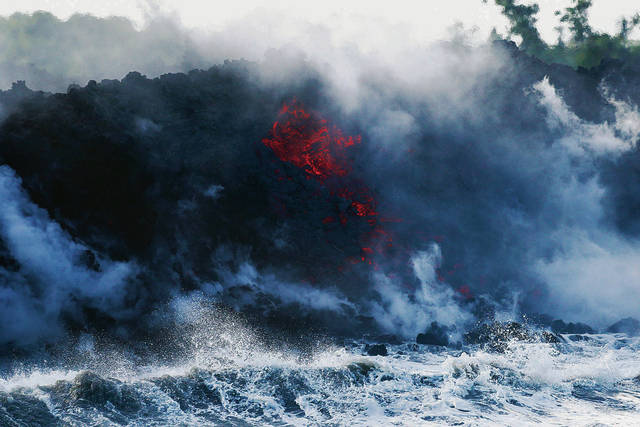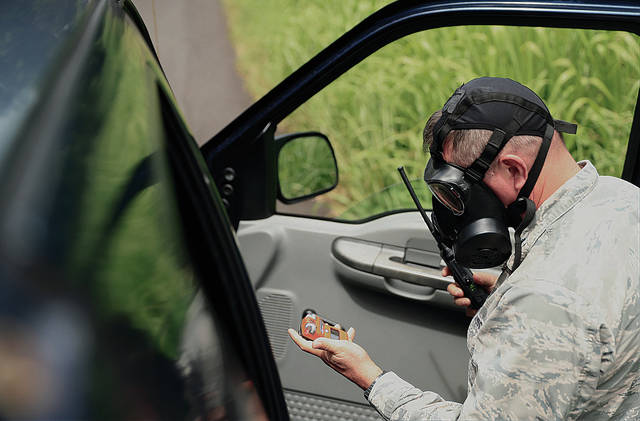Big Isle leads nation in sulfur dioxide emissions

ASSOCIATED PRESS
Lava entered the ocean Sunday, creating “laze” — lava haze — composed of seawater steam, hydrochloric acid and tiny shards of volcanic glass. This mixture has the corrosive properties of diluted battery acid. The corrosive effects of laze can extend far downwind from the ocean entry.

JAMM AQUINO / JAQUINO@STARADVERTISER.COM
Lt. Col. Charles Anthony with the Hawaii Air National Guard monitored sulfur dioxide levels Sunday near the lava flow that overran Highway 137 in Pahoa, Hawaii.


On Sunday the Hawaiian Volcano Observatory issued a new Kilauea Volcano air quality warning — this time about “laze,” short for lava haze.
The hazardous condition results from hot lava coming into contact with cold seawater, producing a dense white plume of steam laced with hydrochloric acid and glass particles, which is now occurring on the island’s southeast coast. The resulting laze plume could reach 15 miles downwind of the ocean entry, according HVO.
>> Affordable rents will bring some Lower Puna residents back home
>> Big Isle leads nation in sulfur dioxide emissions
>> North Carolina sends emergency and fire officials to help in Hilo
>> Big Island family finds Tutu Pele terrifying, but merciful
>> Photos: Lava flow at Leilani Estates, May 20
>> Photos: Lava flow on Highway 137, May 20
>> Photos: Residents learn to move on under Pele’s mercy, May 20
>> Live webcam atop Halemaumau Crater
COMPLETE KILAUEA COVERAGE
>> Star-Advertiser volcano coverage
>> Kilauea Volcano YouTube playlist
But over the years, the volcanic air quality hazard of greatest concern on the Big Island has been vog, a hazy mix of moisture and volcanic gases emanating from the volcano well before U.S. Environmental Protection Agency crews last week installed eight new air monitoring stations to measure new levels of sulfur dioxide and hydrogen sulfide blasting into the air.
Hawaii island has the highest rate of sulfur dioxide emission in the nation — an undisputed distinction established well before this month’s toxic eruptions began pouring from Kilauea Volcano’s East Rift Zone.
Don't miss out on what's happening!
Stay in touch with breaking news, as it happens, conveniently in your email inbox. It's FREE!
In 2016 the EPA rated Hawaii County as having the highest one-hour rate of sulfur dioxide in the U.S.
For context, a study led by Dr. Elizabeth Tam — chairwoman of medicine at the University of Hawaii medical school — found that the air pollution output from Kilauea was equal to one-tenth of the annual pollution for all of China.
Even during dormant periods, sulfur dioxide emission levels were “1,000 times greater than the United States Environmental Protection Agency’s (EPA’s) definition of a major pollution source,” Tam’s team reported in the scientific journal Environmental International in 2016.
“It’s the volcano,” said EPA spokesman Dean Higuchi. “The volcano puts the Big Island highest in the nation for SO2 (sulfur dioxide) values.”
The EPA’s eight new stations augment five that were already on Hawaii island, and they were installed in public spots like schools and close to the East Rift Zone fissures, Higuchi said. The idea is to give state and county officials real-time information on air quality.
“They’re trying to get an early warning of what’s coming out, to warn the community,” Higuchi said.
FEELING ILL
Cathy Santy, 24, is feeling the effects from Kiluaea in her air-conditioned office on the other side of the island in Kailua-Kona.
Santy, a guest services representative at outdoor tour company Hawaii Forest and Trail, said she and two other 20-something office colleagues were worried about the long-term effects of breathing sulfur dioxide, hydrogen sulfide and ash even before Kilauea began erupting May 3.
“A lot of us have headaches,” Santy said. “We’re just tired — muscle aches, headaches. My co-worker was just saying that her eyes are dry and kind of itchy. My other co-worker has a sore throat. We’re all wondering how long it will last. We’re all in our 20s, and I don’t really know if I should be worried about long-term health.”
The answer is unclear, according to Bernadette Longo, an emeritus associate professor of nursing at the University of Nevada, Reno, who led several studies on the health effects of vog.
“I’m not going to say anything about long-term effects because no one’s studied it,” Longo said.
STUDYING VOG
Dr. Tam’s study — which included researchers from the UH School of Ocean Earth Science and Technology, the Harvard School of Public Health and the University of Southern California — looked at lung function among nearly 2,000 Hawaii island schoolchildren from 29 elementary schools and their families from 2002 to 2011 and continued to gather data through 2015.
But Longo said it did not explore the effects from Kilauea on cardiovascular health and other medical issues.
Still, Tam’s study was encouraging.
In the wake of the current Kilauea eruption, Tam did an interview on her study with Tina Shelton, spokeswoman for the UH medical school.
In “the 10 years of study we saw, we didn’t see a higher rate of developing asthma,” Tam said. “We did see if you already have asthma, (vog) does make you cough more.”
Shelton asked Tam about long-term effects on the children in the study, and Tam said there is enough information to conduct follow-up research.
‘EARLY LUNG PROBLEMS’
Josh Green, an emergency room physician and state senator (D, Naalehu-Kailua- Kona), said he treated several patients last week — from the Pahoa evacuation center to the opposite side of Hawaii island in Hawi — for symptoms related to the eruption.
In Kailua-Kona, Green said Friday, “There was soot in the air. I treated several patients with exacerbations of COPD (chronic obstructive pulmonary disease). I treated some older individuals and some young individuals with reactive airway disease; that’s shorthand for not technically having asthma. Some kids came in wheezing. Others had shortness of breath.”
At the evacuation center in Pahoa, Green said about one-third of the 150 patients he treated over three days complained of symptoms related to air quality.
“I saw a lot of people with early lung problems, burning of the throat and eyes, followed by headache and a searing, burning sensation of the lungs,” he said. “They were all related to the SO2. I had to refer three people to the hospital. Very few of them were severe, but you could see it escalating.”
Green was involved in some of the research done by the team from the University of Nevada, Reno, and said, “We did not find there was a correlation to long-term lung disease. But quality of life is affected very significantly if you have headaches, runny eyes, burning throat.”
For the short term, at least, Green said, “It can be brutal.”




